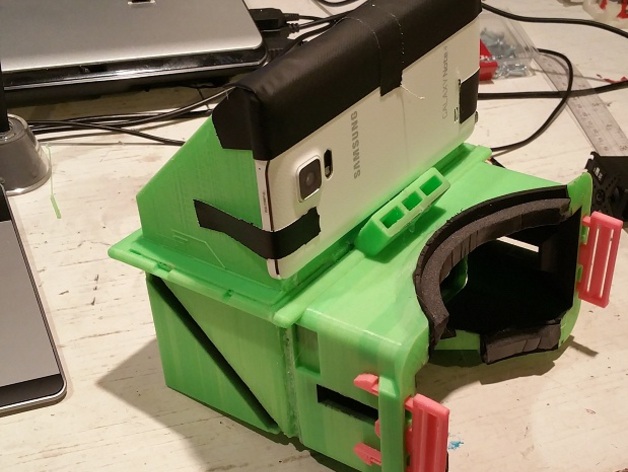
DIY Hololens
thingiverse
I wanted to go ahead and develop Hololens apps. Here is Microsoft's live demo video: https://youtu.be/qym11JnFQBM After experimenting and seeing a couple AR kickstarters, I figured out a way to develop comparable hardware... at least for prototyping. https://youtu.be/omNDLQ4cKnY The HMD costs ~$10 and it projects any mobile phone image enlarged at 16" from the eye. I plan to add a Leap Motion, depth sensor, and/or tracking to be able to interact with virtual objects. Please share! https://twitter.com/seanfultonhall Edit: TBD items: Google Tango tablet integration: All inclusive sensors and mobile form-factor (fastest road to victory):https://www.google.com/atap/project-tango/ Without Google Tango: Depth sensor could also just be a head mounted Kinect using: http://www.thingiverse.com/thing:5601 Head tracking could be done with Playstation Move.me at first: http://code.google.com/p/moveme/ Added ideas not on the real Hololens: Pupil tracking idea here: http://sourceforge.net/projects/haytham/?source=navbar or http://code.google.com/p/pupil/ Update 2015-09-07: Added the two files I used as the base. If you leave off the additional reflector piece, you can experiment with moving the display and lens and even adding more fresnel lenses (easily obtained at Office Depot and online). I had trouble combining them into one mesh. I apologize for it taking so long. I figured this would be at least better for those who have big enough printers to spit this thing out in one shot. I'll keep working on the one-piece version. Update 2015-12-09: I haven't been able to try the real Hololens yet, but from what I can gather, the real Hololens has narrower FOV and does not use pupil tracking for gaze tracking as I have suggested here. From what I have heard, you must point your entire head at things and the FOV is super tiny... can anyone tell me if this is true? I hope to demo it soon, but have been having a lot of near misses when it comes to opportunities to try it for myself. Also I have not been able to determine at what distance the Hololens projects images and whether it is dynamic. Any information would be greatly appreciated and will inspire me to get this thing finished. I appreciate any patience up until this point, as I am transitioning work wise and haven't been able to pursue the software side of things whole-heartedly yet. The Google Tango tablet is a great platform on which all the sensors and processing necessary for the Hololens experience are present. It currently cost $512 compared to the $3000 pricetag on the Hololens. It will probably require separating the screen from the sensors on the back of the tablet, but if anyone has one and is interested, they are but a few steps away from completing the DIY Hololens experience. Instructions Cut a piece of 2.5mm thick plexi-glass or other reflective-transparent material to 95mm x 127mm (or longer). Something akin to this http://www.homedepot.com/p/LEXAN-11-in-x-14-in-x-0-093-in-Clear-Polycarbonate-Sheet-GE-34/205437907?N=5yc1vZbrdg You may have to file the slot that holds it, but otherwise it should slide into place nicely. I actually left the protective film on one side to help with reflection, even at the cost of blurring the real world a little. If you remove it from both sides, there will be a sharp "ghost," or slightly offset double image. I will try some one-way film soon. Currently I have this mirror mounted inside: http://www.amazon.com/dp/B008MB1AZ8/ref=pe_385040_127541860_TE_3p_dp_1 but I'm thinking I need more curvature, so I may replace with bike rear-view or something similiar. Simply mount centered, convex side up, on the inside of the 45 degree angled part on top. And one of these magnifiers is inside as well: http://www.officedepot.com/a/products/787235/Carson-MagniMark-Magnifier/ Cut length down to 153mm (cut off the end with the tie on it) and place over the opening that is created on top before gluing on the two final "additional-reflector" parts. Otherwise, just print and stick (hot glue) the pieces together. I used support material and simply had to rotate some of the pieces to a more suitable orientation for supports. Oh and weather stripping for the face padding! Pending: an actual mount for the phone. I made it for Note3/4, and currently you need to use gaffer's tape or your fingers to hold the phone in place during use. Also pending is a Leap Motion or depth sensor mount for virtual object manipulation. I may even add a Raspberry Pi and camera for gaze detection. Edit: TBD items: Google Tango tablet integration: All inclusive sensors and mobile form-factor (fastest road to victory):https://www.google.com/atap/project-tango/ Without Google Tango: Depth sensor could also just be a head mounted Kinect using: http://www.thingiverse.com/thing:5601 Head tracking could be done with Playstation Move.me at first: http://code.google.com/p/moveme/ Added ideas not on the real Hololens: Pupil tracking idea here: http://sourceforge.net/projects/haytham/?source=navbar or http://code.google.com/p/pupil/
With this file you will be able to print DIY Hololens with your 3D printer. Click on the button and save the file on your computer to work, edit or customize your design. You can also find more 3D designs for printers on DIY Hololens.
